-
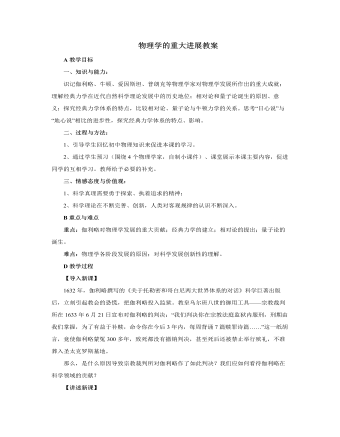
人教版高中历史必修3物理学的重大进展教案
B重点与难点重点:伽利略对物理学发展的重大贡献;经典力学的建立;相对论的提出;量子论的诞生。难点:物理学各阶段发展的原因;对科学发展创新性的理解。D教学过程【导入新课】1632年,伽利略撰写的《关于托勒密和哥白尼两大世界体系的对话》科学巨著出版后,立刻引起教会的恐慌,把伽利略投入监狱。教皇乌尔班八世的御用工具——宗教裁判所在1633年6月21日宣布对伽利略的判决:“我们判决你在宗教法庭监狱内服刑,刑期由我们掌握,为了有益于补赎,命令你在今后3年内,每周背诵7篇赎罪诗篇……”这一纸胡言,竟使伽利略蒙冤300多年,致死都没有撤销判决,甚至死后还被禁止举行殡礼,不准葬入圣太克罗斯墓地。那么,是什么原因导致宗教裁判所对伽利略作了如此判决?我们应如何看待伽利略在科学领域的贡献?

人教版高中历史必修3辉煌灿烂的文学教案
一、知识与能力:(1)了解中国古代不同时期的文学特色;(2)了解、诗,词、歌、赋等各种不同的知识内容和形式,知道和掌握一定数量的名家作品;(3)拓宽文化视野,提高赏析和运用古代文学作品的能力。二、过程与方法:(1)通过教科书及教师提供的材料以及自己的日常积累,通过阅读,讨论,分析,评论了解各个不同时期的文学发展特色。(2)通过阅读,观察,练习,欣赏,表演,评论,创作等方式积极参与教学;通过独立思考或合作学习对所学的内容进行比较,概括和阐释;学会合作学习和相互交流。三、情感态度与价值观:通过本课学习,了解中国古代灿烂的文化。通过对文学家、诗人及其文学作品的分析,把学生带进文学艺术的殿堂,感受古人的呼吸,思想,情操。增强文化修养。
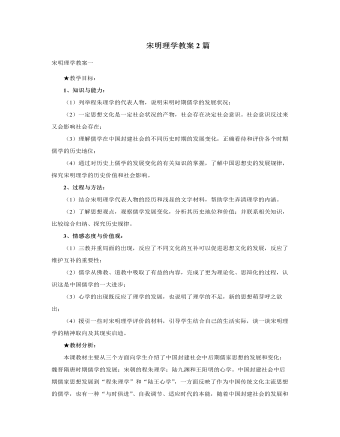
人教版高中历史必修3宋明理学教案2篇
二、程朱理学:1、宋代“理学”的产生:(1)含义:所谓“理学”,就是用“理学”一词来指明当时两宋时期所呈现出来的儒学。广义的理学,泛指以讨论天道问题为中心的整个哲学思潮,包括各种不同的学派;狭义的理学,专指程颢、程颐、朱熹为代表的,以“理”为最高范畴的学说,称为“程朱理学”。理学是北宋政治、社会、经济发展的理论表现,是中国古代哲学长期发展的结果,是批判佛、道学说的产物。他们把“理”或“天理”视作哲学的最高范畴,认为理无所不在,不生不灭,不仅是世界的本原,也是社会生活的最高准则。在穷理方法上,程颢“主静”,强调“正心诚意”;程颐“主敬”,强调“格物致知”。在人性论上,二程主张“去人欲,存天理”,并深入阐释这一观点使之更加系统化。二程学说的出现,标志着宋代“理学”思想体系的正式形成。【合作探究】宋代“理学”兴起的社会条件:

新人教版高中英语必修3Unit 1 Festivals and Celebrations教学设计一
本板块的活动主题是“谈论节日活动”(Talk about festival activities),主要是从贴近学生日常生活的角度来切入“节日”主题。学生会听到发生在三个国家不同节日场景下的简短对话,对话中的人们正在参与或将要亲历不同的庆祝活动。随着全球化的进程加速,国际交流日益频繁,无论是国人走出国门还是外国友人访问中国,都已成为司空见惯的事情。因此,该板块所选取的三个典型节日场景都是属于跨文化交际语境,不仅每组对话中的人物来自不同的文化背景,对话者的身份和关系也不尽相同。1. Master the new words related to holiday: the lantern, Carnival, costume, dress(sb)up, march, congratulation, congratulate, riddle, ceremony, samba, make - up, after all. 2. To understand the origin of major world festivals and the activities held to celebrate them and the significance of these activities;3. Improve listening comprehension and oral expression of the topic by listening and talking about traditional festivals around the world;4. Improve my understanding of the topic by watching pictures and videos about different traditional festivals around the world;5. Review the common assimilation phenomenon in English phonetics, can distinguish the assimilated phonemes in the natural language flow, and consciously use the assimilation skill in oral expression. Importance:1. Guide students to pay attention to the attitude of the speaker in the process of listening, and identify the relationship between the characters;2. Inspire students to use topic words to describe the festival activities based on their background knowledge. Difficulties:In the process of listening to the correct understanding of the speaker's attitude, accurately identify the relationship between the characters.

新人教版高中英语必修3Unit 1 Festivals and Celebrations教学设计三
*wide range of origins(= a great number of different origins, many kinds of origins)*It featured a parade and a great feast with music, dancing, and sports. (=A parade and a great feast with music, dancing, and sports were included as important parts of the Egyptian harvest festival.)*.. some traditions may fade away and others may be established.(= Some traditions may disappear gradually, while other new traditions may come into being.)Step 6 Practice(1) Listen and follow the tape.The teacher may remind the students to pay attention to the meaning and usage of the black words in the context, so as to prepare for the completion of the blanks in activity 5 and vocabulary exercises in the exercise book.(2) Students complete the text of activity 5 by themselves.The teacher needs to remind the students to fill in the blanks with the correct form of the vocabulary they have learned in the text.Students exchange their answers with their partners, and then teachers and students check their answers.(3)Finish the Ex in Activity 5 of students’ book.Step 7 Homework1. Read the text again, in-depth understanding of the text;2. Discuss the origin of festivals, the historical changes of related customs, the influence of commercial society on festivals and the connotation and essential meaning of festivals.3. Complete relevant exercises in the guide plan.1、通过本节内容学习,学生是否理解和掌握阅读文本中的新词汇的意义与用法;2、通过本节内容学习,学生能否结合文本特点快速而准确地找到主题句;3、通过本节内容学习,学生能否理清论说文的语篇结构和文本逻辑,了解节日风俗发展与变迁,感悟节日的内涵与意义。

新人教版高中英语必修3Unit 2 Morals and Virtues教学设计四
3.Teachers ask different groups to report the answers to the questions and ask them to try different sentence patterns.The teacher added some sentence patterns for students to refer to when writing.Step 4 Writing taskActivity 51.Write the first draft.Students first review the evaluation criteria in activity 5, and then independently complete the draft according to the outline of activity 4, the answers to the questions listed in the group discussion and report, and the reference sentence pattern.2.Change partners.The teacher guides the students to evaluate their partner's composition according to the checklist of activity 5 and proposes Suggestions for modification.3.Finalize the draft.Based on the peer evaluation, students revise their own compositions and determine the final draft.Finally, through group recommendation, the teacher selects excellent compositions for projection display or reading aloud in class, and gives comments and Suggestions.Step 5 Showing writingActivity 5T call some Ss to share their writing.Step 6 Homework1. Read the passage in this section to better understand the passage.2. Carefully understand the hierarchical structure of the article, and deeply understand the plot of the story according to the causes, process and results;3. Independently complete the relevant exercises in the guide plan.1、通过本节内容学习,学生是否理解和掌握阅读文本中的新词汇的意义与用法;2、通过本节内容学习,学生能否通过人物言行的对比分析道德故事的深层内涵;3、通过本节内容学习,学生能否根据故事的起因、经过和结果来深入理解故事的情节,从而了解文章的层次结构;4、结合现实生活案例发表自己的见解和看法,写一篇观点明确、层次分明的故事评论。

新人教版高中英语必修3Unit 3 Diverse Cultures教学设计一
Activity 81.Grasp the main idea of the listening.Listen to the tape and answer the following questions:Who are the two speakers in the listening? What is their relationship?What is the main idea of the first part of the listening? How about the second part?2.Complete the passage.Ask the students to quickly review the summaries of the two listening materials in activity 2. Then play the recording for the second time.Ask them to complete the passage and fill in the blanks.3.Play the recording again and ask the students to use the structure diagram to comb the information structure in the listening.(While listening, take notes. Capture key information quickly and accurately.)Step 8 Talking Activity 91.Focus on the listening text.Listen to the students and listen to the tape. Let them understand the attitudes of Wu Yue and Justin in the conversation.How does Wu Yue feel about Chinese minority cultures?What does Justin think of the Miao and Dong cultures?How do you know that?2.learn functional items that express concerns.Ask students to focus on the expressions listed in activity. 3.And try to analyze the meaning they convey, including praise (Super!).Agree (Exactly!)"(You're kidding.!)Tell me more about it. Tell me more about it.For example, "Yeah Sure." "Definitely!" "Certainly!" "No kidding!" "No wonder!" and so on.4.Ask the students to have conversations in small groups, acting as Jsim and his friends.Justin shares his travels in Guizhou with friends and his thoughts;Justin's friends should give appropriate feedback, express their interest in relevant information, and ask for information when necessary.In order to enrich the dialogue, teachers can expand and supplement the introduction of Miao, dong, Lusheng and Dong Dage.After the group practice, the teacher can choose several groups of students to show, and let the rest of the students listen carefully, after listening to the best performance of the group, and give at least two reasons.

新人教版高中英语选修2Unit 4 Reading and thinking教学设计
【词汇精讲】highlight n.最好或最精彩的部分 vt.突出;强调;使醒目One of the highlights of the trip was seeing the Taj Mahal.这次旅行的亮点之一是参观泰姬陵。Your resume should highlight your skills and achievements.你的简历应该突出你的技能和成就。The report highlights the major problems facing society today.报告强调了当今社会所面临的主要问题。I’ve highlighted the important passages in yellow.我用黄色标出了重要段落。7.Edmonton is freezing cold in winter,with daily temperatures averaging -10 ℃.埃德蒙顿冬季寒冷,日平均气温为-10°C。【词汇精讲】freezing adj.极冷的;冰冻的Leave a basin of water outside in freezing weather.在冰冻的天气里,放一盆水在室外。It’s freezing cold outside so wear a warm coat.外面超冷的,所以穿一个暖和一点的外套吧。8.It was not until 9:30 a.m.that they finally reached the capital of Ontario,Toronto.直到上午9时30分,他们才终于到达多伦多的首府安大略省。【句式剖析】本句是一个强调句,强调的是句子的时间状语until 9:30。含有not...until...的句子的强调句为It is not until...that...,that后面的句子要用肯定形式。It was not until then that I suddenly realized nobody was happier than I was.直到那时我才突然意识到没有人比我更幸福了。

新人教版高中英语选修2Unit 2 Reading and thinking教学设计
Her tutor told her to acknowledge __________ other people had said if she cited their ideas, and advised her _______(read) lots of information in order to form __________wise opinion of her own.Now halfway __________ her exchange year, Xie Lei felt much more at home in the UK. She said __________ (engage) in British culture had helped and that she had been__________ (involve) in social activities. She also said while learning about business, she was acting as a cultural messenger __________(build) a bridge between the two countries. keys:Xie Lei, a 19yearold Chinese student, said goodbye to her family and friends in China and boarded (board) a plane for London six months ago in order to get a business qualification. She was ambitious(ambition) to set up a business after graduation. It was the first time that she had left (leave) home.At first, Xie Lei had to adapt to life in a different country. She chose to live with a host family, who can help with her adaptation (adapt) to the new culture. When she missed home, she felt comforted (comfort) to have a second family. Also Xie Lei had to satisfy academic requirements. Her tutor told her to acknowledge what other people had said if she cited their ideas, and advised her to read lots of information in order to form a wise opinion of her own.Now halfway through her exchange year, Xie Lei felt much more at home in the UK. She said engaging (engage) in British culture had helped and that she had been involved (involve) in social activities. She also said while learning about business, she was acting as a cultural messenger building a bridge between the two countries.

新人教版高中英语选修2Unit 2 Using langauge-Listening教学设计
? B: Absolutely! Getting involved with Chinese cultural activities there definitely helped a lot. I got to practice my Chinese on a daily basis, and I could learn how native Chinese speakers spoke.? A: What do you feel is your biggest achievement?? B: Learning Chinese characters! I have learnt about 1,500 so far. When I first started, I didn't think it was even going to be possible to learn so many, but now I find that I can read signs, menus, and even some easy newspaper articles.? A: What are you most keen on?? B: I've really become keen on learning more about the Chinese culture, in particular Chinese calligraphy. As I have learnt Chinese characters, I have developed a great appreciation for their meaning. I want to explore Chinese characters by learning how to write them in a more beautiful way. ? A: Finally, what do you want to say to anyone interested in learning Chinese?? I have really become keen on learning more about the Chinese culture, in particular Chinese Calligraphy. As I have learnt Chinese character, I have developed a great appreciation for their meaning. I want to explore Chinese characters by learning how to write them in a more beautiful way.? A: Finally, what do you want to say to anyone interested in learning Chinese?? B: I'd say, give it a shot! While some aspects may be difficult, it is quite rewarding and you will be happy that you tried.? A: Thanks for your time. ? B:You're welcome.

新人教版高中英语选修2Unit 3 Using langauge-Listening教学设计
1. How is Hunan cuisine somewhat different from Sichuan cuisine?The heat in Sichuan cuisine comes from chilies and Sichuan peppercorns. Human cuisine is often hotter and the heat comes from just chilies.2.What are the reasons why Hunan people like spicy food?Because they are a bold people. But many Chinese people think that hot food helps them overcome the effects of rainy or wet weather.3.Why do so many people love steamed fish head covered with chilies?People love it because the meat is quite tender and there are very few small bones.4.Why does Tingting recommend bridge tofu instead of dry pot duck with golden buns?Because bridge tofu has a lighter taste.5 .Why is red braised pork the most famous dish?Because Chairman Mao was from Hunan, and this was his favorite food.Step 5: Instruct students to make a short presentation to the class about your choice. Use the example and useful phrases below to help them.? In groups of three, discuss what types of restaurant you would like to take a foreign visitor to, and why. Then take turns role-playing taking your foreign guest to the restaurant you have chosen. One of you should act as the foreign guest, one as the Chinese host, and one as the waiter or waitress. You may start like this:? EXAMPLE? A: I really love spicy food, so what dish would you recommend?? B: I suggest Mapo tofu.? A: Really ? what's that?

新人教版高中英语选修2Unit 4 Learning about Language教学设计
This section guides students to pay attention to the typical context of vocabulary use, helps students accumulate vocabulary around the key vocabulary of this unit, and uses the learned words and word chunks in different contexts to deeply understand their meaning and usage, so as to achieve the purpose of review and consolidation.The teaching design activities aim to guide students to pay attention to the typical context in which the target vocabulary is used, as well as the common vocabulary used in collocation, so that students can complete the sentence with correct words. In terms of vocabulary learning strategies, this unit focuses on cultivating students' ability to pay attention to collocation of words and to use word blocks to express meaning.For vocabulary learning, it is not enough just to know the meaning of a single word, but the most important thing is to master the common collocations of words, namely word blocks.Teachers should timely guide students to summarize common vocabulary collocation, such as verb and noun collocation, verb and preposition collocation, preposition and noun collocation, and so on.1. Guide students to understand and consolidate the meaning and usage of the vocabulary in the context, 2. Guide the students to use the unit topic vocabulary in a richer context3. Let the students sort out and accumulate the accumulated vocabulary, establishes the semantic connection between the vocabulary,4. Enable students to understand and master the vocabulary more effectivelyGuiding the Ss to use unit topic words and the sentence patterns in a richer context.

新人教版高中英语选修2Unit 5 Using langauge-Listening教学设计
The theme of this section is to learn how to make emergency calls. Students should learn how to make emergency calls not only in China, but also in foreign countries in English, so that they can be prepared for future situations outside the home.The emergency telephone number is a vital hotline, which should be the most clear, rapid and effective communication with the acute operator.This section helps students to understand the emergency calls in some countries and the precautions for making emergency calls. Through the study of this section, students can accumulate common expressions and sentence patterns in this context. 1.Help students accumulate emergency telephone numbers in different countries and learn more about first aid2.Guide the students to understand the contents and instructions of the telephone, grasp the characteristics of the emergency telephone and the requirements of the emergency telephone.3.Guide students to understand the first aid instructions of the operators.4.Enable Ss to make simulated emergency calls with their partners in the language they have learned1. Instruct students to grasp the key information and important details of the dialogue.2. Instruct students to conduct a similar talk on the relevant topic.Step1:Look and discuss:Match the pictures below to the medical emergencies, and then discuss the questions in groups.
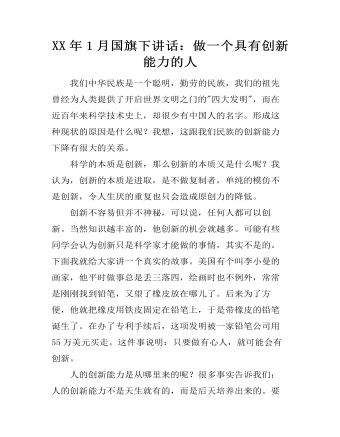
XX年1月国旗下讲话:做一个具有创新能力的人
我们中华民族是一个聪明,勤劳的民族,我们的祖先曾经为人类提供了开启世界文明之门的"四大发明",而在近百年来科学技术史上,却很少有中国人的名字。形成这种现状的原因是什么呢?我想,这跟我们民族的创新能力下降有很大的关系。科学的本质是创新,那么创新的本质又是什么呢?我认为,创新的本质是进取,是不做复制者,单纯的模仿不是创新,令人生厌的重复也只会造成原创力的降低。创新不容易但并不神秘,可以说,任何人都可以创新。当然知识越丰富的,他创新的机会就越多。可能有些同学会认为创新只是科学家才能做的事情,其实不是的。下面我就给大家讲一个真实的故事。美国有个叫李小曼的画家,他平时做事总是丢三落四,绘画时也不例外,常常是刚刚找到铅笔,又望了橡皮放在哪儿了。

乡2023年人居环境整治上半年工作总结和下半年工作计划
一、工作开展情况 (1)“五清一改”整治工作。全乡扎实开展农村人居环境整治专项活动,乡美丽办开展人居环境整治国道和县道巡查5次,通报3次,交办整治任务30余项,河沟渠塘清淤40条约17公里,发动群众投工投劳935人,清理乱搭乱建68处共计1233平米,有效整治了道路沿线有碍观瞻的无功能建筑物,清除破旧广告牌237余块,开展入村宣传450余次,发放相关宣传单2000余份。清理农村生活垃圾743吨,同时清理农村生产废弃物32吨,村庄整治收到良好效果。 (2)美丽乡村建设工程。2020年省级美丽乡村柏山村左家榨中心村和孤峰村孤峰中心村已完成项目验收,正在等待县级报账。2021年市级美丽乡村泉水村塘埂中心村已完成项目验收,正在等待县级报账。2021年省级美丽乡村华盘村油榨中心村建设项目施工方已进场施工,目前已完成亮化工程、古井节点打造、游步道铺设、休闲游园建设,正在进行污水管网的铺设和卫生改厕。2023年市级美丽乡村项目已批复,为泉水村河北中心村和景山村山榜中心村,目前已完成第一轮造价,正在准备招投标事宜。*乡2021年孤峰村、华盘村“生态美”超市已完成建设并投入使用,正在准备2023年新桥村“五美”超市。 (3)改厕工作。2023年我乡10个村共有改厕任务700户,于2023年5月26日-5月27日进行了招投标,截止6月10日已完成改厕392户,预计7月初完成全部改厕任务,后续将开展验收和审计工作。对2021年300户改厕进行了排查,发现3处问题,已安排整改完毕。(4)示范点建设情况。*乡根据我乡实际,每个行政村选择了一到两个村民组进行全覆盖、高标准进行整治,树立整治典型,起到模范作用。目前已完成整治17个示范点,部分示范点达到美丽乡村标准,并实现了百姓参与、家禽圈养。
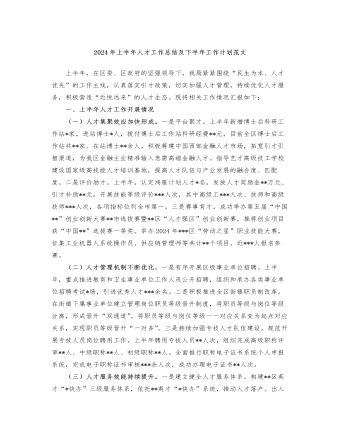
2024年上半年人才工作总结及下半年工作计划范文
二是提速高技能人才培养。推进**艺才高级技工学校打造我区首个技师学院,推动建立*个新职业培训示范基地、*个技能大师工作室、*个“巴渝工匠”乡村驿站,新增*家以上企业自主评价机构,提升技能人才培养层次。力争到2024年底,全区技能人才总量达到**万人,高技能人才总量达到**万人。三是优化人才招聘选拔机制。有序实施全区部门下属事业单位年度招聘工作,开展教育、卫生事业单位赴高校招聘应届优秀大学毕业生,规范开展基层医疗卫生机构考核招聘,进一步做好评比达标表彰工作和创建示范活动,充分发挥表彰激励作用。四是健全联系服务专家制度。坚持把搭建事业平台、发挥专家作用作为联系服务的重点,为专家创新创业提供良好条件,组织开展区内专家休假、疗养、学术交流“三位一体”活动,探索“学养结合”服务模式,打造各领域高层次人才交流互动平台。
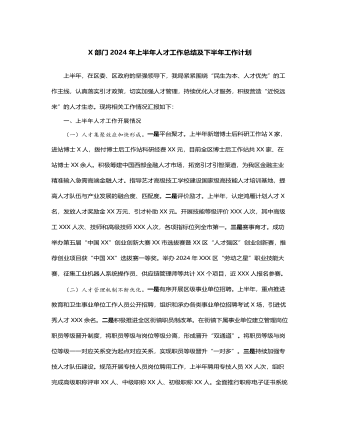
X部门2024年上半年人才工作总结及下半年工作计划
二是提速高技能人才培养。推进XX艺才高级技工学校打造我区首个技师学院,推动建立X个新职业培训示范基地、X个技能大师工作室、X个“巴渝工匠”乡村驿站,新增X家以上企业自主评价机构,提升技能人才培养层次。力争到2024年底,全区技能人才总量达到XX万人,高技能人才总量达到XX万人。三是优化人才招聘选拔机制。有序实施全区部门下属事业单位年度招聘工作,开展教育、卫生事业单位赴高校招聘应届优秀大学毕业生,规范开展基层医疗卫生机构考核招聘,进一步做好评比达标表彰工作和创建示范活动,充分发挥表彰激励作用。四是健全联系服务专家制度。坚持把搭建事业平台、发挥专家作用作为联系服务的重点,为专家创新创业提供良好条件,组织开展区内专家休假、疗养、学术交流“三位一体”活动,探索“学养结合”服务模式,打造各领域高层次人才交流互动平台。
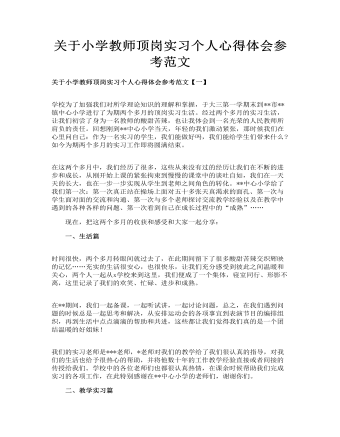
关于小学教师顶岗实习个人心得体会参考范文
在实习的日子里,我们主要负责二年级、五年级和六年级的体育课教学。在实习最开始的时候我们看指导老师上课,以一个“老师”的身份看他是如何上课的,学习他如何传授知识、驾驭课堂,如何控制授课时间等等。通过听课我发现教师不仅对知识和技能的把握很重要,对学生的课堂纪律、积极性的调动都很重要。只有把握好课堂纪律、学生学习的积极性,才能让我们的学生在上课的时候真正的学到运动技能,并真正达到锻炼身体的目的。
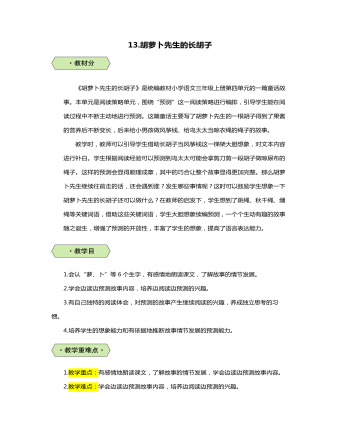
统编版三年级语文上胡萝卜先生的长胡子教案
1.胡萝卜先生的胡子可真长啊!胡萝卜先生继续走着,接下来会发生什么有趣的事情呢?(学生发挥想象,预测接下来的故事情节。) 2.自读课文第4-8自然段,看看与你们自己的预测一样不一样吧!学生自己读故事,发现自己的预测和文本内容不一样时及时修正自己的想法。(1)出示关键句:线实在太短了,他的风筝只能飞过屋顶。根据课文内容,预测接下来的故事发展。(2)出示关键句:鸟太太正在找绳子晾小鸟的尿布。根据插图中鸟太太遇见胡萝卜先生惊喜的神态,预测接下来的故事发展。 3.文章写完了吗?为什么?(结尾的省略号就告诉我们这个故事还没有结束。) 既然没有结束,我们就来续编故事吧!可以结合上面的男孩的语言、动作续编故事,也可以有自己新奇的想法。大家之前预测的故事发展只要合乎情理也可以继续预测。
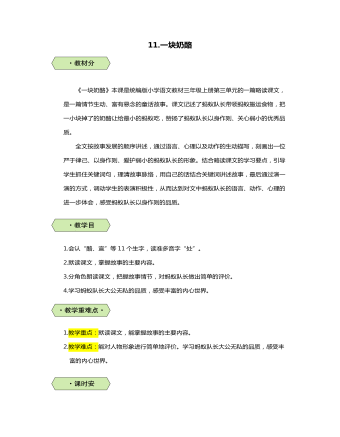
统编版三年级语文上一块奶酪教案
(1)板书“奶酪”,学生齐读。 (2)提问:二年级时,我们学过哪个关于奶酪的故事?(学生自由回答)(3)教师小结:是啊,在《狐狸分奶酪》这个故事里,为了从小熊兄弟的手里骗走美味的奶酪,狐狸可真是费尽心机哪!2.引导:今天我们要学的课文也讲到了奶酪,小蚂蚁想方设法搬奶酪,看来奶酪很诱人呢!奶酪的味道到底怎么样呢?我们一起来品味品味吧。(板书课题,学生跟读)3.设疑激趣(1)出示课文中的句子: ◇奶酪多诱人啊!抬着它,不要说吃,单是闻闻,都要淌口水。 ◇他低下头,嗅嗅那点儿奶酪渣,味道真香!



